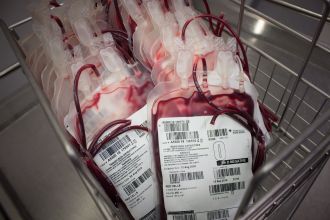Media release
From:
New research shows GPs key to unlocking lifesaving donations from people with common blood disorder
A new study published in the Australian Journal of General Practice highlights the crucial role of general practitioners in directing people with haemochromatosis to donate their blood for lifesaving purposes, rather than having it discarded at pathology services.
Haemochromatosis, a condition that causes iron overload, is commonly treated through venesection – regular blood removal. When referred to Australian Red Cross Lifeblood, their treatment becomes a lifesaving act by donating their blood for use in the national supply.
The study, which surveyed over 4,300 donors with haemochromatosis, found that nearly half (48.3%) of respondents chose to donate at Lifeblood because their GP recommended it.
Additionally, 62.5% donated at Lifeblood because they knew their blood would help others, reinforcing the importance of GP communication about this benefit.
Lifeblood last year revealed that 73,000 bags of blood are being discarded annually, largely because up to two-thirds of therapeutic venesections for hereditary haemochromatosis in Australia occur outside of Lifeblood centres.
The Lifeblood, Hemochromatosis Australia, and Royal Australian College of GPs (RACGP) campaign resulted in a significant lift in donations by people with haemochromatosis, with 2,500 more donations made and an extra 7,500 lives saved.
Lead author of the study and Senior Medical Officer at Lifeblood Dr Peter Bentley said GP guidance is instrumental in helping patients understand their haemochromatosis treatment can also save lives.
“GPs are not just treating iron overload - they’re empowering patients to contribute to the national blood supply, with demand at a 12-year high across Australia,” Dr Bentley said.
“But we believe many GPs remain unaware that 87% of therapeutic donations at Lifeblood are used to make products for clinical use, where the donor meets all eligibility criteria, and that referring therapeutic donors to Lifeblood is not only possible but highly desirable.”
The study also found that 74.4% of donors reported their GP had no difficulty referring them to Lifeblood.
Patients whose doctors did experience problems said their GP had difficulty with providing the required information and a lack of awareness of the referral tool.
“We’ve made significant improvements to the High Ferritin App and referral pathways, but awareness remains a barrier,” Dr Bentley added.
“We’re currently conducting focus groups with GPs to make even more improvements, particularly to make the referral form easier to use and the information needed clearer.”
RACGP Vice President Dr Ramya Raman urged GPs to discuss donating through Lifeblood with patients living with haemochromatosis and could consider using Apps like the High Ferritin App to make referrals where they practice,"
“It’s profound to have something as important as blood donation be part of how you provide care,” she said.
"Apps such as the High Ferritin App can help GPs discuss care and enable easier referral pathways. Referrals are as simple as several questions about a patient’s health and history, contact information, and Lifeblood takes care of the rest,"
“For patients, treating haemochromatosis by donating blood means their treatment can be easier, free, and truly rewarding,"
“Lifeblood also recently expanded donation eligibility, so it’s a great time to review how you manage iron overload. Many cancer survivors and men who have sex with men can now donate through Lifeblood,"
“It’s a win-win – patients receive essential treatment, and their donations help others.”
For more information on how to refer patients with the High Ferratin App, visit highferritin.transfusion.com.au
Case study for inclusion in stories – David Grant
66-year-old David Grant has been giving blood to Lifeblood at Bundoora Blood Donor Centre in Victoria since 2022 to manage Heamaochromatosis. He has also given 25 donations of plasma in between his 12 blood donations, meaning he has helped to save more than 100 lives. David was one of the first donors in Australia with Hemochromatosis to start giving plasma.
David moved to Australia 20 years ago, and discovered he had Hemochromatosis through regular blood tests for diabetes. He had been a regular blood donor since the age of 18, which had masked the condition.
“I was initially donating my blood at my GPs surgery, which cost $100 each time, and they were throwing it out,”
“I then discovered the Red Cross would do it for free. I feel like a donor rather than a patient at Lifeblood, I love being able to use my condition to help save lives.”
Multimedia




 Australia; VIC; QLD; WA
Australia; VIC; QLD; WA



